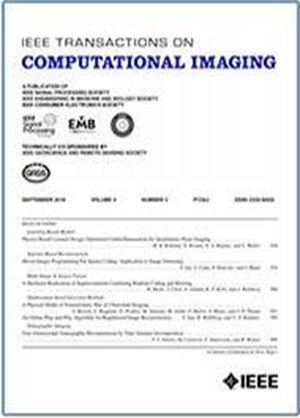Batch-FPM: Random Batch-Update Multi-Parameter Physical Fourier Ptychography Neural Network
IF 4.8
2区 计算机科学
Q2 ENGINEERING, ELECTRICAL & ELECTRONIC
引用次数: 0
Abstract
Fourier Ptychographic Microscopy (FPM) is a computational imaging technique that enables high-resolution imaging over a large field of view. However, its application in the biomedical field has been limited due to the long image reconstruction time and poor noise robustness. In this paper, we propose a fast and robust FPM reconstruction method based on physical neural networks with batch updated optimization strategies, capable of achieving attractive results with low single-to-noise ratio and correcting multiple system parameters simultaneously. Our method leverages a random batch optimization approach, breaks away from the fixed sequential iterative order and gives greater attention to high-frequency information. The proposed method has better convergence performance even for low signal-to-noise ratio data sets, such as low exposure time dark-field images with an exposure time equal to one percent of the normal. As a result, it can greatly increase the image recording and result reconstruction speed without any additional hardware modifications. By utilizing advanced deep learning optimizers and perform parallel computational scheme, our method enhances GPU computational efficiency, significantly reducing reconstruction costs. Experimental results demonstrate that our method achieves near real-time digital refocusing of a 1024 × 1024 pixels region of interest on consumer-grade GPUs. This approach significantly improves temporal resolution (by reducing the exposure time of dark-field images), noise resistance, and reconstruction speed, and therefore can efficiently promote the practical application of FPM in clinical diagnostics, digital pathology, and biomedical research, etc. In addition, we believe our algorithm scheme can help researchers quickly validate and implement FPM-related ideas.批处理- fpm:随机批处理更新多参数物理傅立叶平面神经网络
傅里叶平面显微镜(FPM)是一种计算成像技术,可以在大视场上实现高分辨率成像。然而,由于图像重建时间长,噪声鲁棒性差,限制了其在生物医学领域的应用。在本文中,我们提出了一种基于物理神经网络的快速鲁棒FPM重建方法,该方法具有批更新优化策略,能够以低单噪比和同时校正多个系统参数获得有吸引力的结果。我们的方法利用随机批优化方法,摆脱了固定的顺序迭代顺序,更多地关注高频信息。即使对于低信噪比的数据集,如曝光时间为正常值1%的低曝光时间暗场图像,该方法也具有较好的收敛性能。因此,它可以大大提高图像记录和结果重建的速度,而无需任何额外的硬件修改。该方法利用先进的深度学习优化器和并行计算方案,提高了GPU的计算效率,显著降低了重构成本。实验结果表明,我们的方法在消费级gpu上实现了1024 × 1024像素感兴趣区域的近实时数字重聚焦。该方法显著提高了时间分辨率(通过减少暗场图像的曝光时间)、抗噪性和重建速度,可以有效地促进FPM在临床诊断、数字病理、生物医学研究等方面的实际应用。此外,我们相信我们的算法方案可以帮助研究人员快速验证和实现与fpm相关的想法。
本文章由计算机程序翻译,如有差异,请以英文原文为准。
求助全文
约1分钟内获得全文
求助全文
来源期刊

IEEE Transactions on Computational Imaging
Mathematics-Computational Mathematics
CiteScore
8.20
自引率
7.40%
发文量
59
期刊介绍:
The IEEE Transactions on Computational Imaging will publish articles where computation plays an integral role in the image formation process. Papers will cover all areas of computational imaging ranging from fundamental theoretical methods to the latest innovative computational imaging system designs. Topics of interest will include advanced algorithms and mathematical techniques, model-based data inversion, methods for image and signal recovery from sparse and incomplete data, techniques for non-traditional sensing of image data, methods for dynamic information acquisition and extraction from imaging sensors, software and hardware for efficient computation in imaging systems, and highly novel imaging system design.
 求助内容:
求助内容: 应助结果提醒方式:
应助结果提醒方式:


